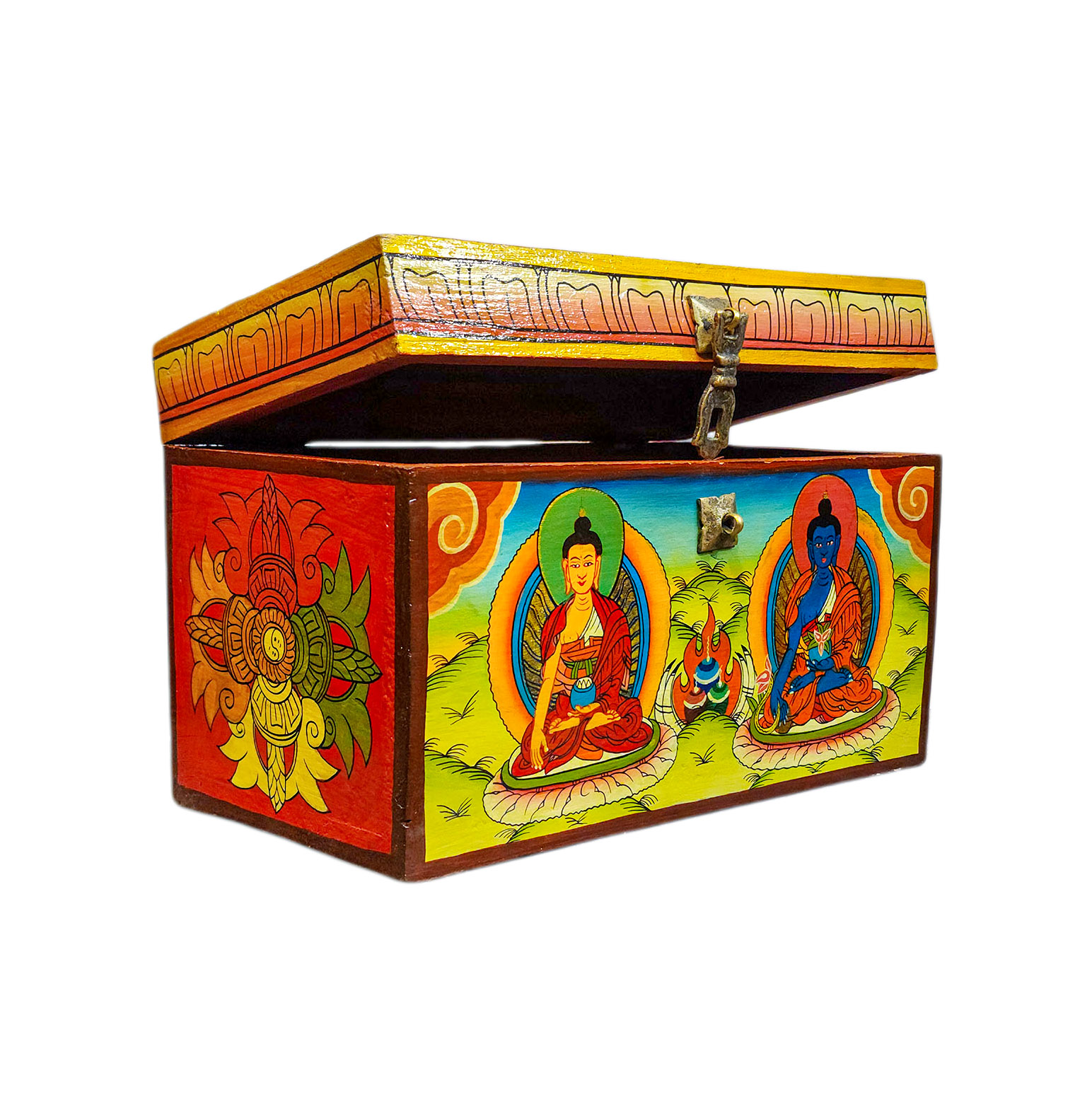Ritual Discount
We are providing 15% price on all ritual Items.
Wooden Tibetan Box
A Tibetan wooden box is a handcrafted storage container made from wood and often adorned with intricate Tibetan motifs and vibrant colors. These boxes are typically crafted by skilled artisans using traditional techniques passed down through generations. The decorations on the box usually include symbols of good fortune, such as lotus flowers, endless knots, dragons, or mythical creatures, and are painted in vivid hues like red, blue, green, and gold. These motifs not only add to the aesthetic appeal but also carry significant cultural and spiritual meanings in Tibetan Buddhism.
Read More
Decorative Item: Tibetan wooden boxes are highly valued as decorative pieces that add a touch of elegance and cultural richness to any room. Their vivid colors and intricate designs make them a focal point on shelves, mantels, or coffee tables, enhancing the aesthetic appeal of a space.
Storage: These boxes are functional storage items, perfect for keeping small treasures, jewelry, incense, prayer beads, or other personal items safe. They often come in various sizes, making them suitable for different storage needs.
Gift: A Tibetan wooden box makes a thoughtful and unique gift, especially for those who appreciate art, culture, or spiritual artifacts. It can serve as a memorable keepsake for special occasions.
Spiritual Use: In Tibetan culture, these boxes may also be used in religious settings to store sacred objects, texts, or ritual items, preserving them in a manner that respects their spiritual significance.
Overall, Tibetan wooden boxes are not just storage items but also serve as beautiful decorative pieces that can bring a touch of Tibetan culture and spirituality into any home. Their vibrant colors and intricate designs make them a unique addition to any interior decor, while their functionality and craftsmanship are a testament to the rich artistic traditions of Tibet.
Buddha : About Buddha
Gautama Buddha, popularly known as the Buddha, He is regarded as the founder of the world religion of Buddhism, and revered by most Buddhist schools as a savior, the Enlightened One who rediscovered an ancient path to release clinging and craving and escape the cycle of birth and rebirth. He taught for around 45 years and built a large following, both monastic and lay. His teaching is based on his insight into the arising of duḥkha and the ending of duhkha the state called Nirvana
The Buddha was born into an aristocratic family in the Shakya clan but eventually renounced lay life. According to Buddhist tradition, after several years of mendicancy, meditation, and asceticism, he awakened to understand the mechanism which keeps people trapped in the cycle of rebirth. The Buddha then traveled throughout the Ganges plain teaching and building a religious community. The Buddha taught a middle way between sensual indulgence and the severe asceticism found in the Indian śramaṇa movement. He taught a training of the mind that included ethical training, self-restraint, and meditative practices such as jhana and mindfulness. The Buddha also critiqued the practices of Brahmin priests, such as animal sacrifice and the caste system.
A couple of centuries after his death he came to be known by the title Buddha, which means "Awakened One" or "Enlightened One". Gautama's teachings were compiled by the Buddhist community in the Vinaya, his codes for monastic practice, and the Suttas, texts based on his discourses. These were passed down in Middle-Indo Aryan dialects through an oral tradition. Later generations composed additional texts, such as systematic treatises known as Abhidharma, biographies of the Buddha, collections of stories about the Buddha's past lives known as Jataka tales, and additional discourses, i.e. the Mahayana sutras.
Read More
About Color Finishing
The Wooden Tibetan Box is adorned with traditional colors, creating a captivating aesthetic through a combination of gold and various hues. This painting technique follows a time-honored process that aims to faithfully represent the Wooden Tibetan Box in accordance with traditional color descriptions. In the context of Buddhist statues, this approach holds great significance. Each statue has its own primary color, and it is crucial to depict the statue in its authentic shade.
This adherence to color accuracy is akin to the meticulous artistry seen in thangka paintings. To achieve this finishing, organic colors and genuine gold are used, while the expertise of a skilled thangka artist is sought, as painting on a metal surface requires a distinct set of skills to bring out the elegance and beauty of the statue.
By employing this traditional coloring method, the Wooden Tibetan Box is not only aesthetically pleasing but also maintains its cultural authenticity, paying homage to the rich traditions and practices associated with Buddhist art.
Read More
